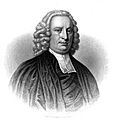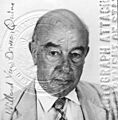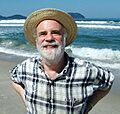American philosophy facts for kids
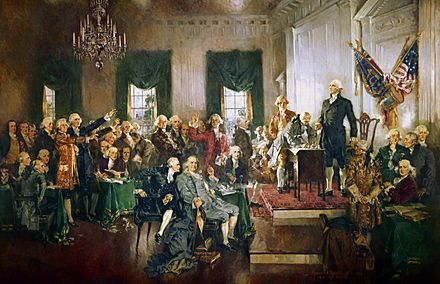
American philosophy is all about the ideas and ways of thinking that have come from philosophers in the United States. It doesn't have one single main idea, but it has helped shape what it means to be American throughout history.
Contents
Early American Ideas (1600s)
American philosophy started when educated Puritans arrived in New England. Their early ideas were often about religion, especially how God's plan (Providentialism) affected everything. They also thought a lot about the connection between a person and their community. You can see these ideas in early documents like the Fundamental Orders of Connecticut (1639) and the Massachusetts Body of Liberties (1641).
Some thinkers, like John Winthrop, believed that public life was more important than private life. Others, like Roger Williams (who helped start Rhode Island), felt that religious tolerance was more important than everyone in a community believing the same things.
The 1700s: New Ways of Thinking
In the 1700s, American philosophy changed. The first half was still influenced by religious ideas, especially from the First Great Awakening. But it also started to mix with new ideas from the Age of Enlightenment. The second half focused on moral philosophy taught in colleges. These ideas helped create a new way of thinking for the United States, especially for the Founding Fathers and their political ideas.
During this time, American thinkers learned about philosophers like Francis Bacon, Descartes, Newton, and Locke. Two Americans, Samuel Johnson and Jonathan Edwards, were among the first to use these Enlightenment ideas. They used them to create their own American religious and philosophical ideas. Both were religious leaders and college presidents. They were also important in shaping the political ideas of the Founding Fathers.
Enlightenment Comes to America
For about 100 years, colleges in the American Colonies mostly taught Puritan religious ideas. But in 1714, Yale received a gift of 800 books from England. These books contained "The New Learning," including works by Locke, Descartes, and Newton. A young student named Samuel Johnson discovered these books. He felt like he had stepped "out of the glimmer of twilight into the full sunshine."
Johnson started teaching these new Enlightenment ideas at Yale in 1716. This is often seen as the start of the American Enlightenment. One of his students was a young Jonathan Edwards. Both became important thinkers and college presidents. They explored new ideas about things like free will and original sin.
Jonathan Edwards and Reformed Calvinism
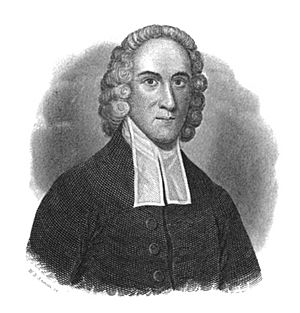
Jonathan Edwards was a very important religious philosopher in America. He was known for powerful sermons, like "Sinners in the Hands of an Angry God," which helped start the First Great Awakening. Edwards believed strongly in the "absolute power of God." He used ideas from philosophers like George Berkeley and Newton to explain his religious views.
Edwards believed that our minds have understanding and will. He thought that objects have properties because they "resist," which he saw as God's power at work. For example, in Newton's laws of motion, an object "resists" changing its movement.
Even though Edwards used Enlightenment ideas, he remained a Calvinist. He believed that people don't have true free will when it comes to salvation. He said, "we can do as we please, but we cannot please as we please." According to Edwards, salvation comes only from God's grace, not from good deeds or faith we create ourselves.
Enlightenment Ideas and Morality
The 1700s brought more focus on science and new learning from the Age of Enlightenment. There was also a belief that people could become better through learning ethics and moral philosophy. This led to new ideas about economics and politics.
Samuel Johnson is sometimes called "The Founder of American Philosophy." He wrote the first philosophy textbook published in the colonies. Johnson was interested in philosophy, religion, and how to organize knowledge. He used his ideas to write encyclopedias and create college courses.
Johnson believed that "true religion is morality." He thought that different religions could agree on a common moral philosophy. He created his own moral philosophy, influenced by Descartes, Locke, and William Wollaston. He also studied with George Berkeley. Johnson disagreed with the idea of predestination and believed people had free will and natural rights. His ideas, called "American Practical Idealism," were taught in colleges and influenced many important people.
It's thought that about half of American college students between 1743 and 1776 were influenced by Johnson's ideas. Many of the men who helped write the Declaration of Independence were connected to his philosophy. For example, Benjamin Franklin was his friend and publisher. Johnson's son, William Samuel Johnson, was even the chairman of the committee that wrote the U.S. Constitution.
Founders' Political Ideas
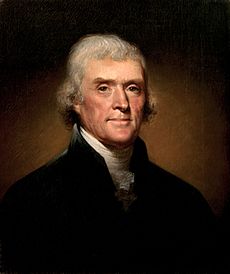
Around the time of the Stamp Act, people became very interested in government and political ideas. Many Founding Fathers, like John Adams, Thomas Jefferson, and James Madison, wrote a lot about these topics. They discussed how God, the government, and individuals should relate to each other. This led to the United States Declaration of Independence (1776) and the United States Constitution (1788).
The Constitution created a federal and republican government. It has a system of checks and balances to divide power among three branches: the judicial (courts), the executive (President), and the legislative (Congress).
The Declaration of Independence mentions a Creator and Divine Providence. While some Founding Fathers, like Franklin and Jefferson, had ideas similar to deism (belief in a God who created the world but doesn't interfere), most were members of Christian churches. However, the ideas of "the Laws of Nature, and Nature's God" and "the pursuit of Happiness" in the Declaration show the influence of Enlightenment thinking.
Another set of ideas, called Scottish Common Sense philosophy, was brought to American colleges in 1768 by John Witherspoon. He was a Scottish minister and helped debate the Declaration. Some historians have debated how much this Scottish philosophy influenced the founding documents. However, it seems that Samuel Johnson's "American Practical Idealism" and Jonathan Edwards's religious ideas had a stronger impact on the men who wrote the Declaration.
Thomas Paine, an English writer, also greatly influenced political ideas in America. His pamphlet Common Sense gave reasons for the American Revolution and independence from Britain.
In short, in the mid-1700s, college students who learned these new ideas helped create the important documents of the American nation. Older thinkers like Samuel Johnson and Jonathan Edwards taught the idea of "the pursuit of Happiness" to the generation who became the Founding Fathers.
The 1800s: New American Ideas
The 1800s saw the rise of Romanticism in America, especially a unique form called transcendentalism. This century also brought the important school of thought known as pragmatism.
Transcendentalism
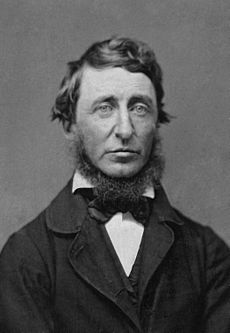
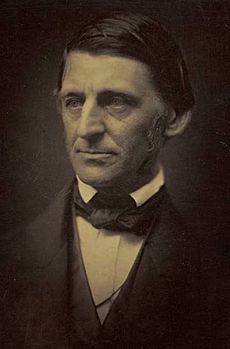
Transcendentalism in the U.S. focused on personal experience. It was a reaction against too much focus on science and machines. Transcendentalists believed in an ideal spiritual state that goes beyond the physical world. They thought you could reach this state through your own intuition and by reflecting on nature, not just through science or traditional religion.
Key transcendentalist writers included Ralph Waldo Emerson, Henry David Thoreau, and Margaret Fuller. They all wanted people to reconnect with nature. They believed that true knowledge comes from personal experience in nature, not just from scientific facts.
They felt that things like scientific tools, government rules, and traditional religious rules needed to be "transcended" or gone beyond. For example, in Henry David Thoreau's book Walden; or, Life in the Woods, he shows how living simply in nature and away from society can help you find deeper truths.
Darwin's Ideas in America
When Charles Darwin published his theory of evolution in 1859 (in On the Origin of Species), it greatly affected American philosophy. Thinkers like John Fiske and Chauncey Wright explored how evolution could explain morality and the mind. This led to new fields like evolutionary psychology.
Darwin's ideas were also used in social and political philosophy by Herbert Spencer and William Graham Sumner. Spencer, who used the phrase "survival of the fittest," believed that societies were in a struggle. He thought this struggle was good because it would make humanity stronger in the long run. This idea is called Social Darwinism.
Sumner, influenced by Spencer, believed that laissez-faire capitalism (where the government doesn't interfere much with business) was the best economic system. He thought it would lead to the most well-being.
Pragmatism: A Truly American Idea
The most important and unique American way of thinking is pragmatism. It started in the late 1800s with Charles Sanders Peirce, William James, and John Dewey. Pragmatism begins with the idea that a belief is something you are willing to act on. It says that the meaning of an idea comes from the practical actions or results that would happen if you believed it were true.
Charles Sanders Peirce
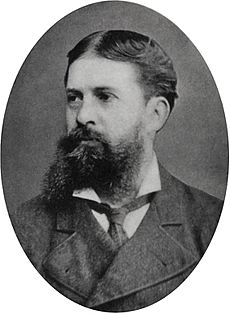
Charles Sanders Peirce (1839–1914) was a very smart person who studied many subjects, including logic, math, and philosophy. He created the term "pragmatism" in the 1870s. He wrote two important essays, "The Fixation of Belief" (1877) and "How to Make Our Ideas Clear" (1878), which are seen as the start of pragmatism.
In "The Fixation of Belief," Peirce argued that the scientific method is the best way to figure out what is true. In "How to Make Our Ideas Clear," he explained the "pragmatic maxim." This maxim says: "Think about what practical effects you imagine an object to have. Then, your idea of these effects is your whole idea of the object." This means that the meaning of an idea is all about its possible practical results.
Peirce's philosophy also included ideas like fallibilism (that we can always be wrong) and the belief that truth can be found. He also thought about how we make sense of signs and how we learn new things.
William James

William James (1842–1910) was a very original thinker in psychology and philosophy. He wrote famous books like The Varieties of Religious Experience and The Principles of Psychology.
James, like Peirce, saw pragmatism as a new way to make ideas clear and solve problems. In his book Pragmatism: A New Name for Some Old Ways of Thinking (1910), James explained Peirce's idea: "The real meaning of our thoughts comes from the possible differences in how we act." He also thought pragmatism was a theory of truth itself. Peirce, however, disagreed, saying pragmatism was just a method, not a theory of truth.
James is also known for "radical empiricism," which says that the connections between things are as real as the things themselves. He also believed there could be many correct ways to understand truth.
John Dewey
John Dewey (1859–1952) was another important pragmatist. He wrote a lot about politics and society, and he was very involved in public life. Dewey was also a key figure in the progressive education movement in the U.S.
Dewey argued that social groups and rules are not just for individuals. Instead, he believed that society helps create individuals and helps them become free.
Dewey is famous for his ideas on the philosophy of education. He believed that children learn best by "doing." He thought that traditional schooling was too long and formal. He suggested that children should learn through real-life activities. For example, they could learn math by figuring out cooking proportions or travel times.
The 1900s: New Directions
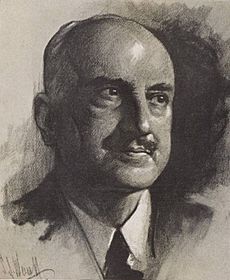
In the 1900s, other philosophical ideas joined pragmatism in America. Eventually, these new ideas became very popular. The 20th century saw the rise of "process philosophy," influenced by Albert Einstein's ideas about relativity. Later, "analytic philosophy" and the "philosophy of language" became very popular. While Existentialism was big in Europe, it wasn't as popular in America.
Rejecting Idealism
Pragmatism continued to be important in the 20th century. George Santayana, a Spanish-American philosopher, was a leading supporter of pragmatism and realism. He thought that idealism (the idea that reality is based on our minds) went against common sense. He believed that if we need absolute certainty to have knowledge, then we might not be able to know anything at all.
In his book Scepticism and Animal Faith, Santayana said that knowledge isn't just about reasoning. Instead, it's what we need to act and deal with the world successfully. He was a naturalist, meaning he believed that the natural world is all there is. He thought science should explain events in nature, while philosophers should study their meaning and value.
Process Philosophy
Process philosophy was influenced by Einstein's ideas about the world. Key thinkers included Alfred North Whitehead and Charles Hartshorne. The main idea of process philosophy is that events and processes are the most important things in reality. Whitehead said that things in nature are like a series of events that keep a certain character. This philosophy is like the ancient Greek idea that everything is always changing. Charles Hartshorne also used Whitehead's ideas to develop "process theology."
Analytic Philosophy Takes Over

In the mid-1900s, analytic philosophy became very popular in America. This way of thinking started in Europe with philosophers like Gottlob Frege and Bertrand Russell. Logical positivists, a group within analytic philosophy, believed that only statements that could be proven by logic or science were meaningful. Ideas about ethics, art, or religion, they thought, were meaningless. When Adolf Hitler rose to power, many positivists moved from Germany to Britain and America, which helped analytic philosophy spread.
W.V.O. Quine was not a logical positivist, but he agreed that philosophy should be clear and scientific. He criticized some of their ideas in his essay "Two Dogmas of Empiricism." Quine believed that all our beliefs are connected in a "web of belief." He thought that no experience happens alone; everything is linked.

Saul Kripke, a student of Quine, has greatly influenced analytic philosophy. He is known for his work on modal logic (logic about what is possible and necessary) and his lectures Naming and Necessity, which changed how people thought about language and metaphysics. He also contributed to the study of truth.
David Kellogg Lewis, another student of Quine, was also a very important philosopher. He is known for his idea of modal realism. This is the idea that there are an infinite number of real, separate "possible worlds," and our world is just one of them. These possible worlds are used in modal logic.
Thomas Kuhn was an important philosopher of science. He wrote The Structure of Scientific Revolutions, a very famous book. He argued that science doesn't just grow steadily. Instead, it goes through "paradigms" (ways of thinking). When scientists find new problems they can't solve with the old paradigm, a "paradigm shift" happens, and a new way of thinking takes over.
Political Philosophy Returns

For a while, American philosophy focused on abstract ideas. But in the 1970s, it returned to social and political issues, which had been important during the founding of the U.S.
One influential figure was Ayn Rand, who promoted her philosophy called Objectivism in her novels, The Fountainhead (1943) and Atlas Shrugged (1957). Objectivism says there is an objective reality we can know through reason. It believes people should act in their own rational self-interest, and that laissez-faire capitalism is the best economic system. While popular with some, her work is often debated by academic philosophers.
In 1971, John Rawls published A Theory of Justice. He presented his idea of "justice as fairness," which is a version of the social contract theory. Rawls used a thought experiment called the "veil of ignorance." In this idea, people imagine they don't know their own race, religion, wealth, or other personal details. From this "original position," they would choose fair principles for society. Rawls argued for a system where any social or economic differences must benefit the least advantaged people the most.
Robert Nozick, a libertarian philosopher, disagreed with Rawls. In his 1974 book Anarchy, State, and Utopia, he argued for a very small government, called a "minimal state." He believed the government's role should only be to provide police, national defense, and courts. All other services, like education or welfare, should be handled by private groups or charities.
Nozick supported the "entitlement theory of justice." This theory says that if people get their possessions fairly (through earning, transfer, or fixing past wrongs), then any distribution of wealth, even if very unequal, is fair. It doesn't matter if it fits a certain pattern, only how it was acquired.
Alasdair MacIntyre, a philosopher from the United Kingdom who lived and worked in the U.S., helped bring back interest in virtue ethics. This is a moral theory from the ancient Greek philosopher Aristotle. MacIntyre believes that modern society lacks a clear moral code and a sense of purpose. He suggests returning to strong communities where people can learn virtues.
Outside of universities, the Civil Rights Movement and the writings of Martin Luther King, Jr. brought social and political concerns to the forefront. King was a Christian minister and activist who fought for civil rights through nonviolence.
Feminism

While there were earlier feminist writers like Sarah Grimké and Charlotte Perkins Gilman, the second-wave feminism movement of the 1960s and 1970s had a big impact on philosophy.
Betty Friedan's book The Feminine Mystique was very popular. Other feminist philosophers, like Alicia Ostriker, questioned basic ideas and values, including what they saw as male-focused ways of thinking about ethics. They argued that no inquiry is truly neutral and that philosophical issues have important social dimensions.
Today's Philosophy
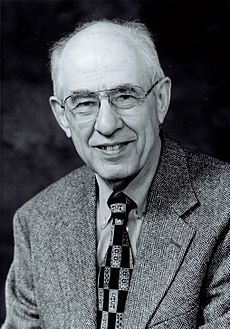
Toward the end of the 1900s, there was new interest in pragmatism. This was largely due to philosophers like Hilary Putnam and Richard Rorty. Rorty is known for his books Philosophy and the Mirror of Nature and Philosophy and Social Hope. Hilary Putnam is known for his work on the philosophy of mind, language, and science, including his famous "brain in a vat" thought experiment.
Today, debates in the philosophy of mind are very important. American philosophers like Hilary Putnam, Donald Davidson, Daniel Dennett, and John Searle continue to discuss the nature of the mind and the "hard problem of consciousness" (how physical processes create conscious experience).
In the early 2000s, "embodied cognition" became a stronger idea. This theory says that the mind, body, and world are all connected. Philosophers like Shaun Gallagher and Alva Noë support this view, seeing it as a natural step from pragmatism and other past philosophies.
Important American legal philosophers like Ronald Dworkin and Richard Posner work on political philosophy and law. Posner is known for using economics to understand legal rules. Dworkin is famous for his theory of "law as integrity," where he argues that law should be seen as a consistent story.
Philosopher Cornel West is known for his analysis of American culture, especially regarding race, gender, and class issues. He is also connected to pragmatism and transcendentalism.
Alvin Plantinga is a Christian analytic philosopher. He is known for his "free will defense" against the problem of evil (why a good God allows suffering). He also argues that belief in God can be a "properly basic" belief, meaning it doesn't need other beliefs to support it.
See also
 In Spanish: Filosofía en Estados Unidos para niños
In Spanish: Filosofía en Estados Unidos para niños
Images for kids
-
Jonathan Edwards was a famous religious thinker.
-
Thomas Jefferson was a key Founding Father.
-
Henry David Thoreau was a famous Transcendentalist.
-
Ralph Waldo Emerson was a key leader of Transcendentalism.
-
Charles Sanders Peirce was a brilliant thinker who started pragmatism.
-
William James was a famous American pragmatist and psychologist.
-
George Santayana was a philosopher who wrote about pragmatism and realism.
-
Willard Van Orman Quine was a very important analytic philosopher.
-
Saul Kripke is a very influential analytic philosopher.
-
The John Fitzgerald Kennedy Memorial in Dallas, Texas.
-
Betty Friedan was a key figure in the feminist movement.
-
Hilary Putnam helped bring back interest in pragmatism.



